
Castlefield, Manchester
Picture Gallery : Collections
A Tale of Two Cities – Manchester Revisited
by Julie Schwethelm
It’s been a very long time since I’ve visited my home town of Manchester. Too long. After an absence of eight years I decided it was high time. Then came Covid. When all the lockdowns and restrictions were finally over, the thought of being at an airport with all those other humans was simply too daunting. Last year I very boldly booked my husband and me flights and accommodation, only to have the flights cancelled by EasyJet three weeks before we were due to depart. It was a mixture of disappointment and relief, as the airport scenes in the media were not exactly confidence inspiring. Pictures of crowds trying to check in or pass through security but not getting anywhere, people fondly bidding farewell to their luggage, wondering if they would ever see it again. So we postponed for another year.
At the end of May 2023 we finally made it and landed in Manchester on time and without any stress whatsoever. That must be a record. I had been reading so many Facebook posts about the changing face of Manchester and was wondering if I’d be able to recognize it without a tourist guidebook. Even Manchester Town Hall and the Albert Memorial are heavily disguised in their white wrapping paper during refurbishment (and what a surprise that it’s going to take longer and by the way will be just a tad more expensive than planned). Our hotel was on Cross Street next door to Boots so it was very convenient and far enough away from today’s version of Piccadilly Gardens. I shan’t start to reminisce about the sunken gardens of yore as it would take up too much space.
With the impending rail strikes (on three out of four days, chapeau!), I’d rearranged our plans and abandoned the little rail journeys in favour of bus trips. This meant a change of destinations of course. However I must say the public transport services have improved vastly as far as the buses go, in that you can use one ticket for any bus. I remember standing at bus stops, equipped with Stagecoach Megarider tickets, waiting forever while a seemingly endless stream of buses from at least three other companies passed by.
After attending two fascinating and inspiring MLFHS Oldham Branch Zoom talks by Douglas Jackson on Joseph Briggs and then on the Tiffany Windows, I thought a trip to Haworth Art Gallery just outside Accrington would be interesting. So off we went, in search of one of those elusive Manchester bus stops for the limited stop bus to Accrington. The journey took us through the lovely Lancashire countryside and only cost us two pounds each.
Haworth Art Gallery is well worth a visit. It is Lancashire’s finest Arts & Crafts house and garden. It was designed by the architect Walter Brierley, and houses Europe’s largest Tiffany glass collection, donated by Joseph Briggs, a local lad who made his fortune in America, ending up managing director of Tiffany Studios. The collection is beautifully displayed and provides a wealth of information on the various glass making techniques.
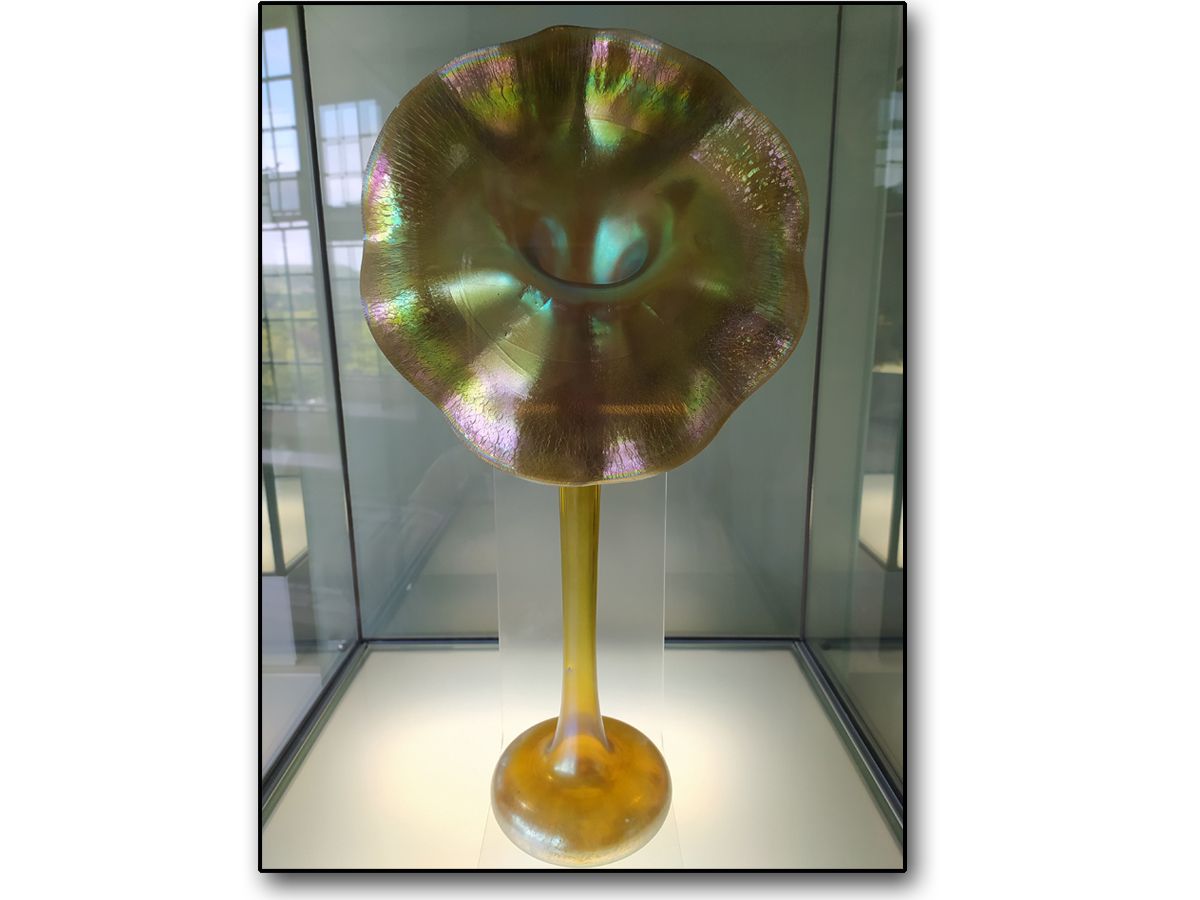
Tiffany iridescent gold Jack-in-the-Pulpit glass vase
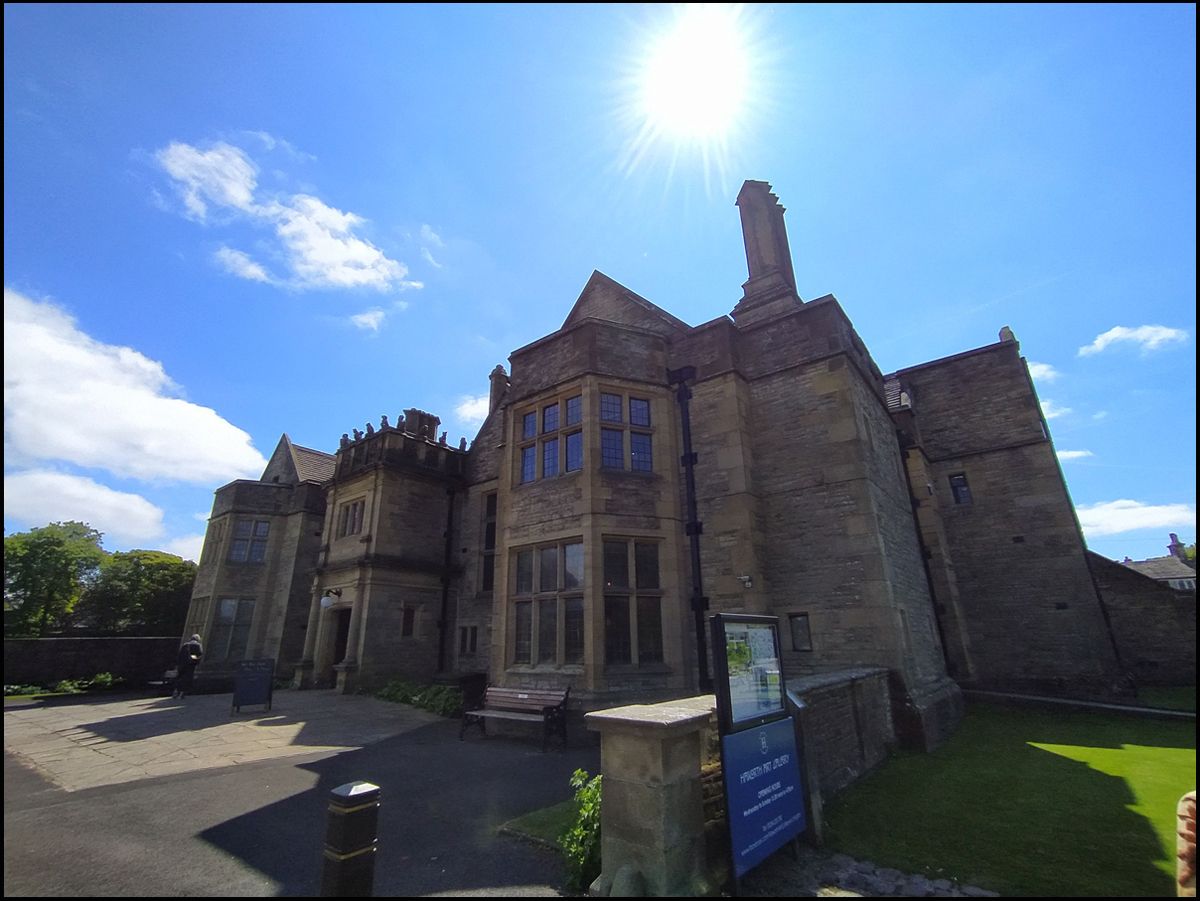
Haworth Art Gallery
By way of contrast we opted for a tour of Ancoats the following day. The first official recording of the area dates back to 1212 when it was called ‘Elnecot’ – a name derived from the Old English ‘Ana Cots’ or ‘lonely cottages’.
The 1800s changed this radically as it became known as “the world’s first industrial suburb” with a multitude of mills that earned Manchester its nickname ‘cottonopolis’. With the closure of the mills much of Ancoats degenerated into an industrial wasteland, which is more or less how I remember it. Our bus from Droylsden ran through Ancoats, passing Star Hall, the Salvation Army Hospital, then Ancoats Hospital and then along Great Ancoats Street. It was dark and dismal and gloomy and Lowry-like. I can remember two buildings which looked very different, one of them has even survived the upheaval of redevelopment – the beautiful Art Déco Daily Express building. I’ve even been inside, my father had a photographer friend who might have worked there, I can’t remember, but I do remember the enormous printing machines and those impressive rolls of paper, not to mention the racket. Another Art Déco building was J.G. Neeedham, “Ladies Coats Costumes”, later they sold fabrics if I remember rightly. It always looked slightly out of place amidst the rows of little shops. It didn’t survive. Ash of Ancoats sticks in my mind, I remember gaping through grimy bus windows at hundreds of ladders stacked outside the shop. And of course Volmax where you could buy anything that could be stored comfortably in the garden shed.
And today? Ancoats has disposed of its flavour-of-the-1980s central retail park with Toys ‘R’ Us, JD Sports, a DIY shop which I somehow link to W.H. Smith and no doubt a string of others I fail to recall, and has completely reinvented itself, and is moreover considered one of the coolest places to live and eat out.
We began our walk at New Islington, me feeling completely lost with absolutely no landmarks to cling onto. We passed the Chips building with its newsprint as a reminder of the Daily Express, then walked along the Ashton Canal which leads to Islington Marina with its waterside bars and restaurants overlooking Cottonfield Park, and made our way to Cutting Room Square with St Peter's, the rehearsal venue for the Halle Orchestra. There were people sitting drinking coffee (don’t ask me which fancy type of coffee) outside the Ice Plant building, so called because it had an ice-making plant, was used for the storage of chilled goods. It was also a distribution centre for the ice-cream barrows that operated in this area in the nineteenth century. We reached Anita Street, originally called Sanitary Street, one of the first with municipal houses in Manchester. They were built to replace back to back terraced houses with no sanitation.
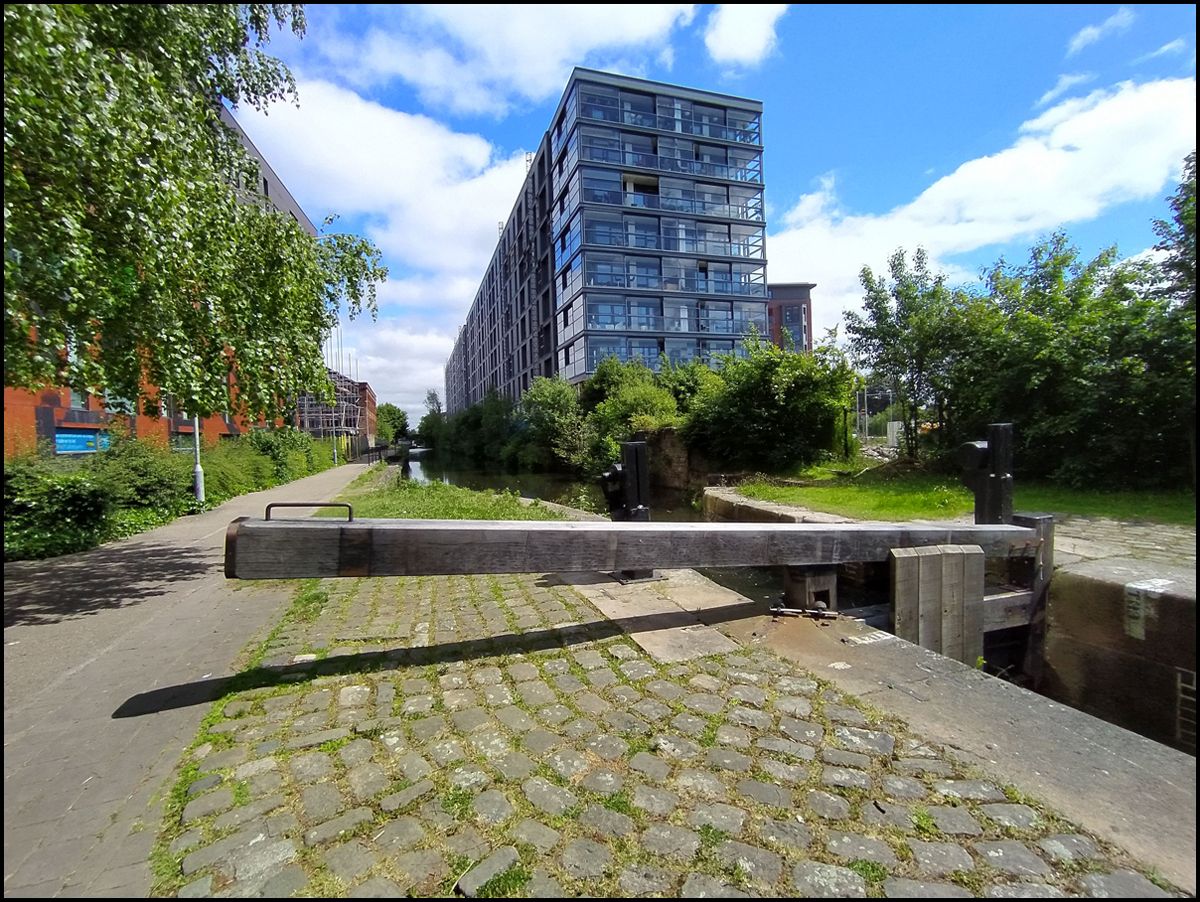
Ashton Canal, New Islington, Ancoats
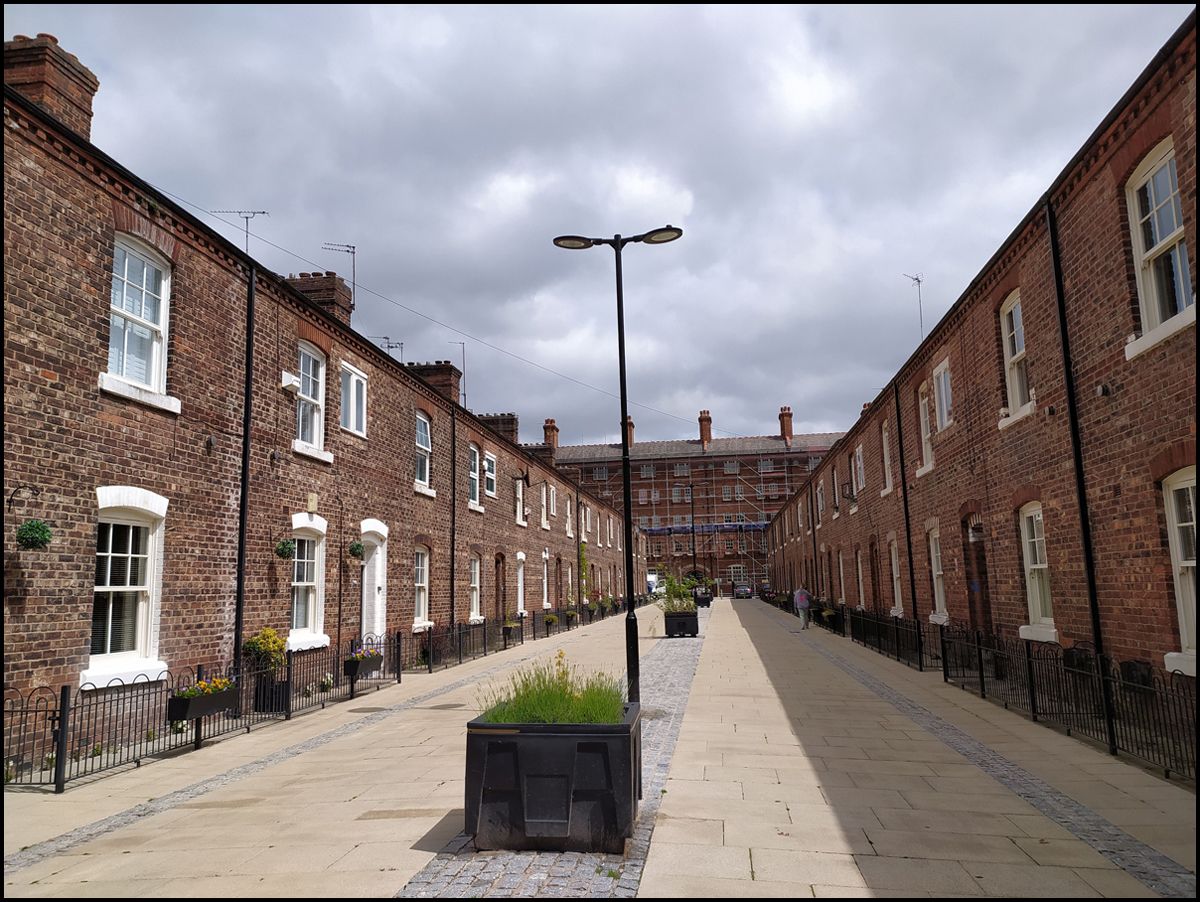
Anita Street, Ancoats
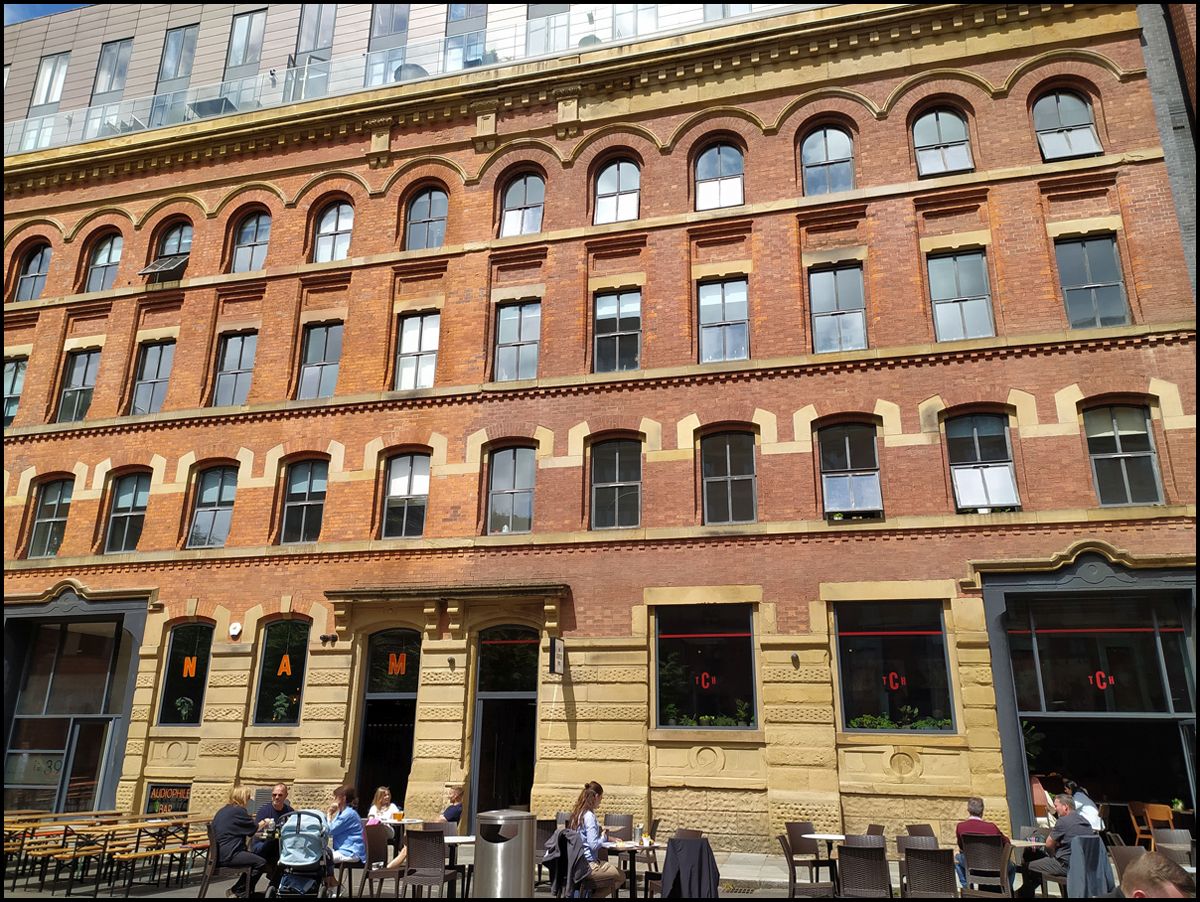
Ice Plant Building, Cutting Room Square, Ancoats
Urban regeneration with hip housing for (affluent) young people (with small dogs) brings with it gentrification. Not all the inhabitants are happy. I wonder what Friedrich Engels would have thought? My personal opinion? I find it somewhat overrated and most likely overpriced, although I must admit the Ashton and Rochdale Canals definitely look much better for the facelift.
Whit Friday! That means Tameside Whit Friday Brass Band Contest, if you revolve in a circle with brass band connections. Which we do, so there we were in Carrbrook on a balmy early summer’s evening, families spread out on blankets on the grass watching the bands as they marched onto the little stage. My friend Christine explained the procedure and how the judging is carried out by people surreptitiously cowering in unobtrusive caravans and tents with their clipboards. Very English, that. There was that familiar grassy smell I associate with Daisy Nook fair on Good Friday when I was a child. A kind of garden fête scenario with bunting and refreshment stalls and lots of people walking about generally enjoying the atmosphere. And maybe occasionally paying attention to the band.
On Saturday I finally managed to cross the moat and discover Clayton Hall. It’s within walking distance of where I grew up at the North Road end of Droylsden. I remember a derelict building hiding in the trees during the sixties. In the later seventies the council used the building as an administrative base, but pretended it wasn’t there. Now it's a beautiful hands on museum and definitely worth a visit. And you might even bump into somebody you know. What a coincidence that the volunteer lady who welcomed me just happens to be the elder sister of a childhood playmate!
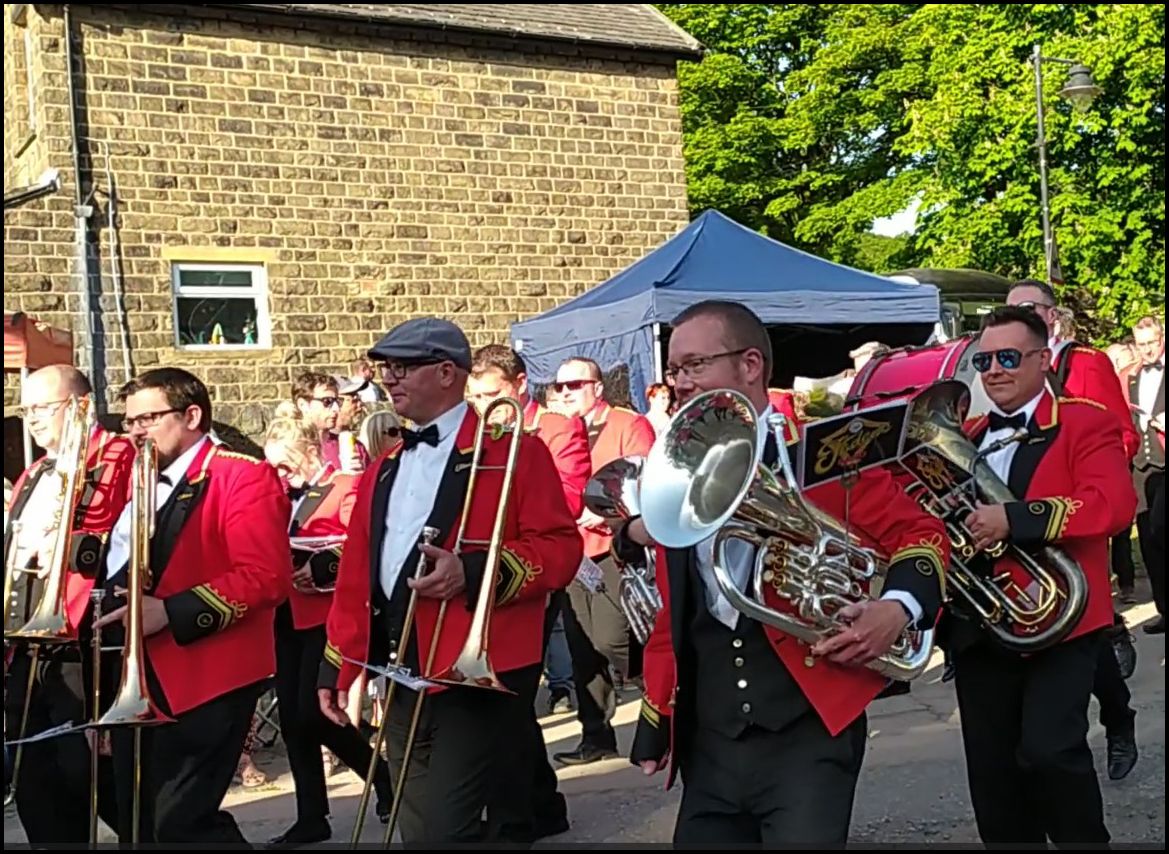
Tameside, Whit Friday Brass Band Contest in Carrbrook
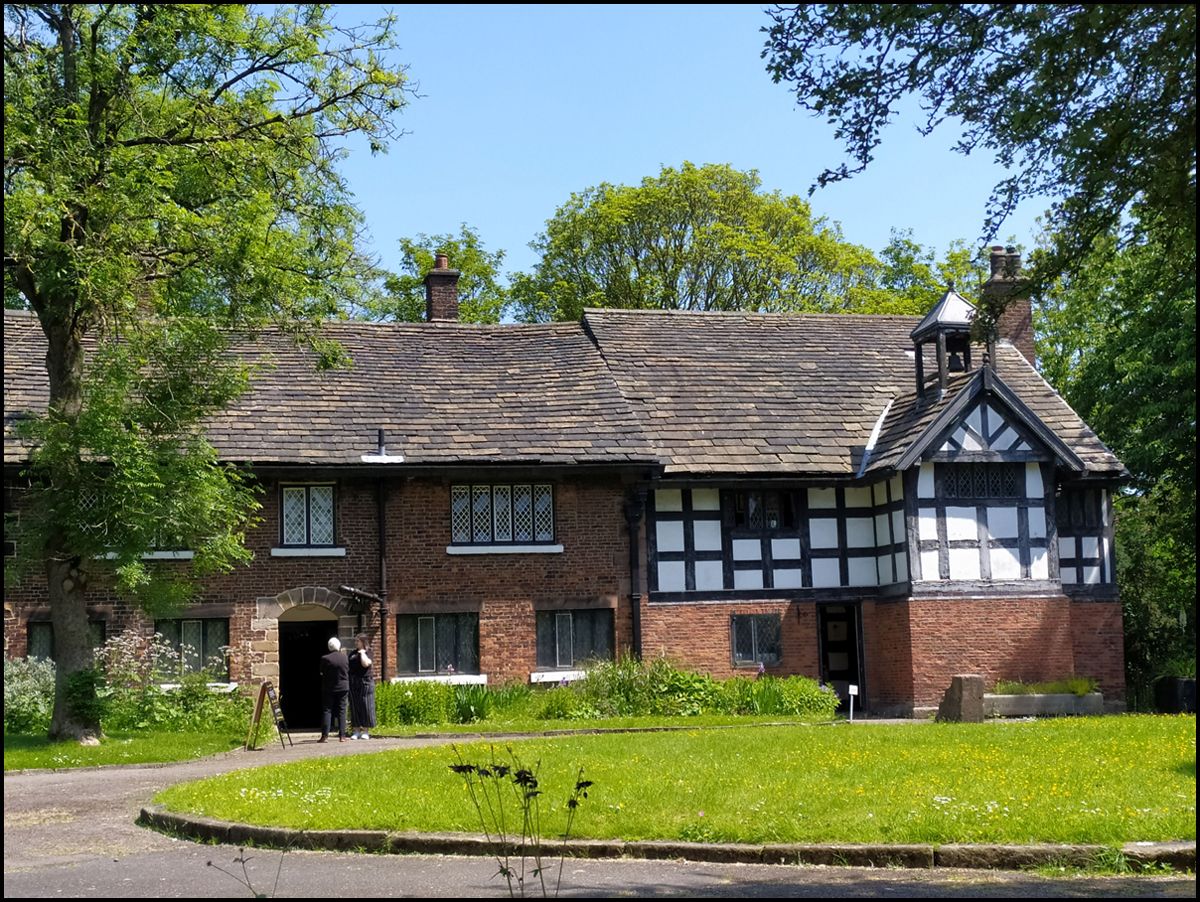
Clayton Hall
From the lovely renovated Clayton Hall to the wastelands of Villemomble Square in Droylsden. I compared two photographs, before and after. One picture was taken in 2009 when there were flower beds, benches, trees and shops. Today's picture with half a tree is a sad witness to the decline of Droylsden town centre. Even the police station is being converted into flats. The lamp has been dismantled and the mullioned windows replaced. So much for Concord and Industry, Droylsden’s motto.
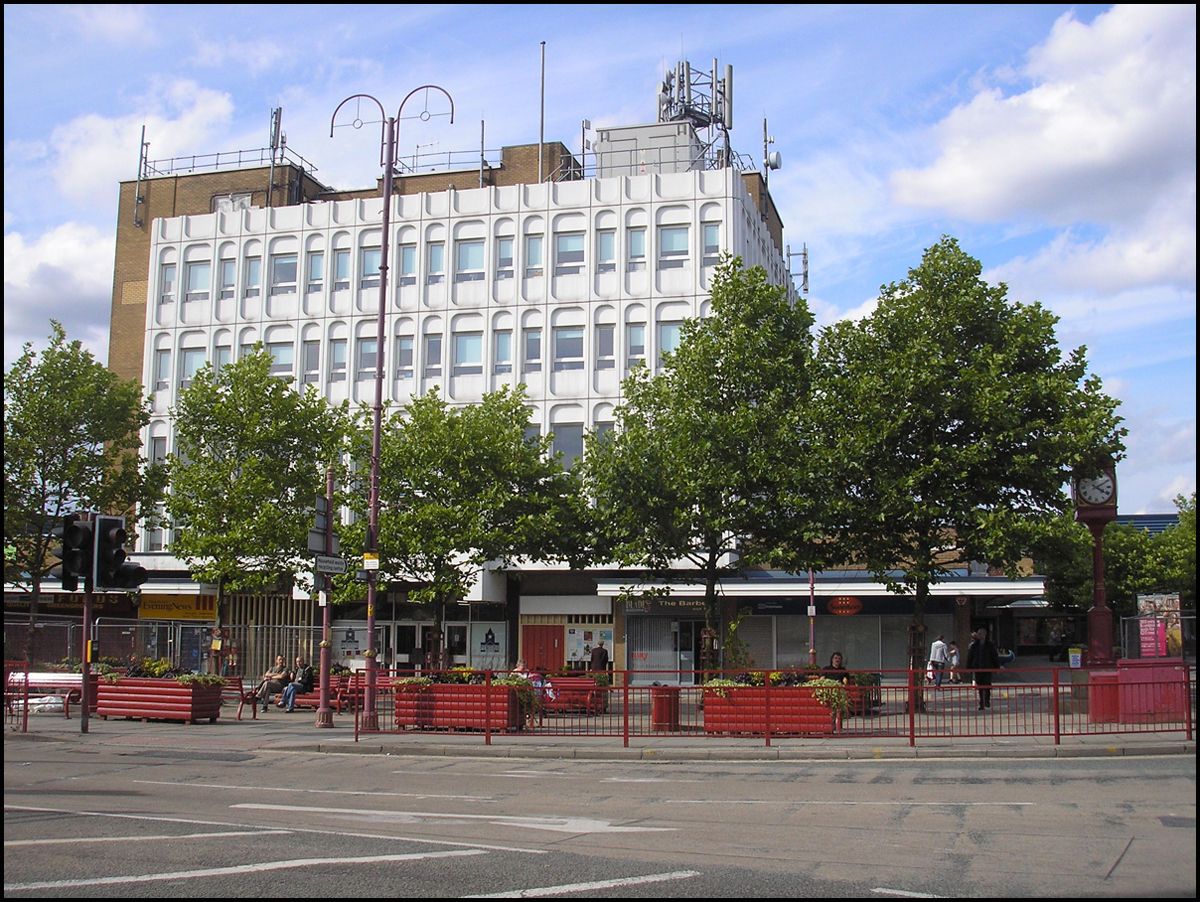
Droylsden Precinct
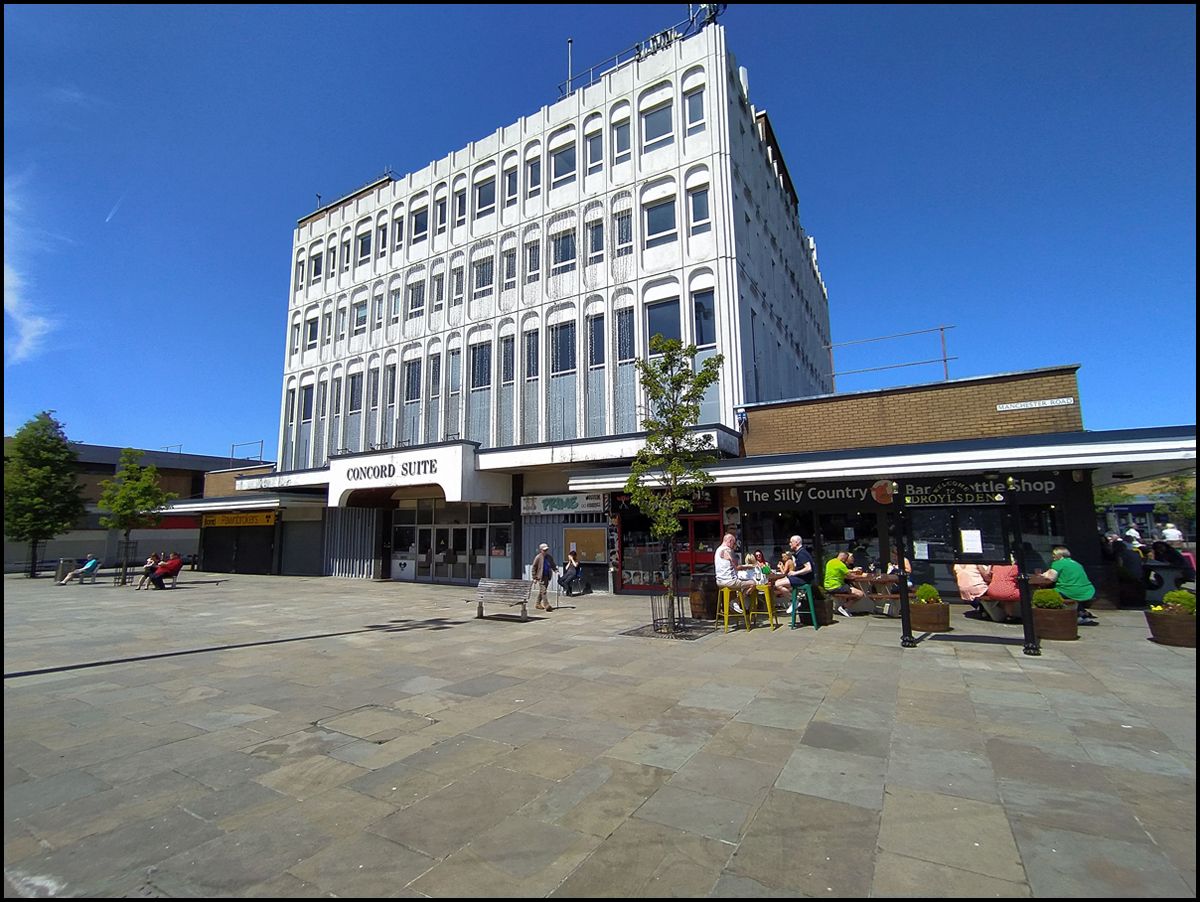
Villemomble Square, Droylsden
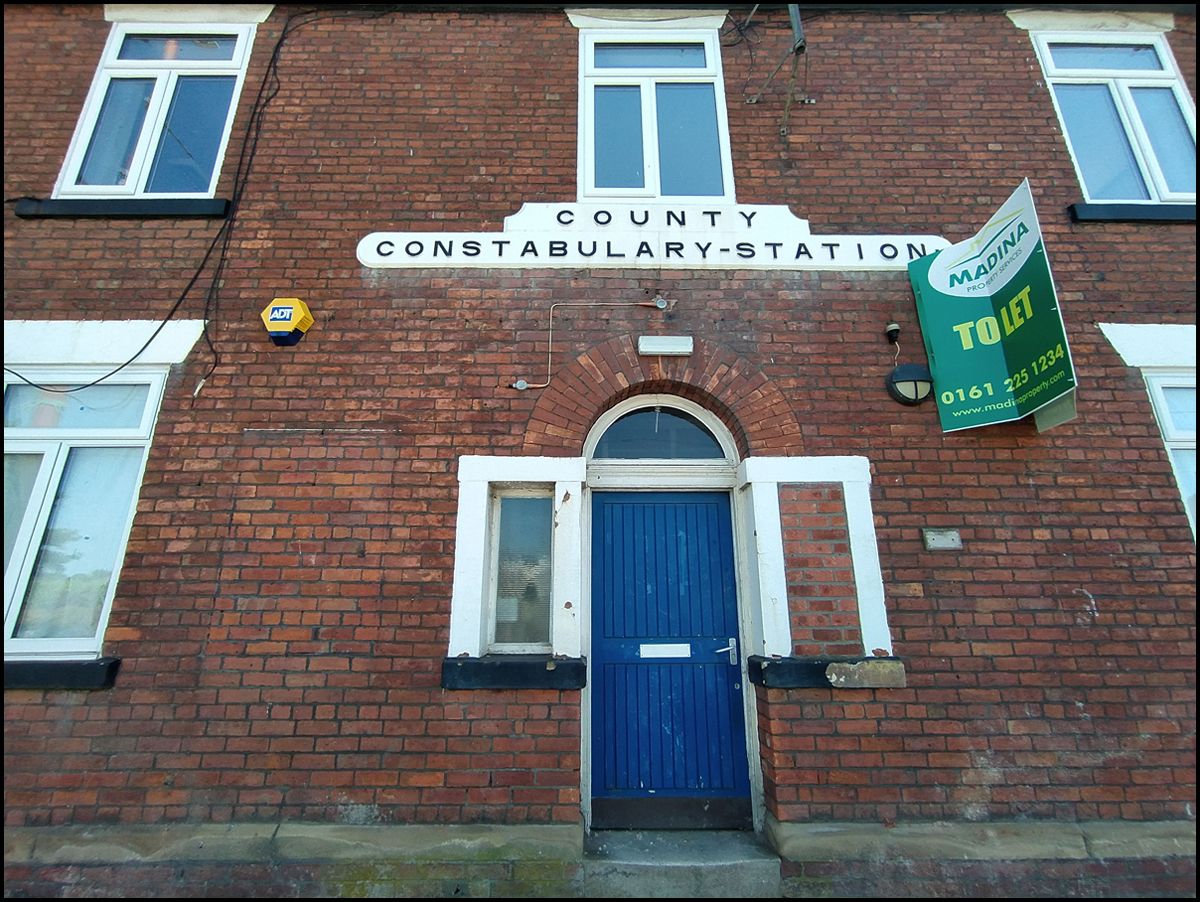
Droylsden Police Station
Droylsden Marina however is definitely an improvement. The Ashton Canal was filled in during the sixties, once they’d fished out all the old prams and bicycles, and mutated into a mass of ugly tarmac. You can now stand beside the marina and look directly towards Manchester Road where the old library used to be. Unfortunately, the old library built in 1937 has been demolished. And I always used to think it was a listed building..…
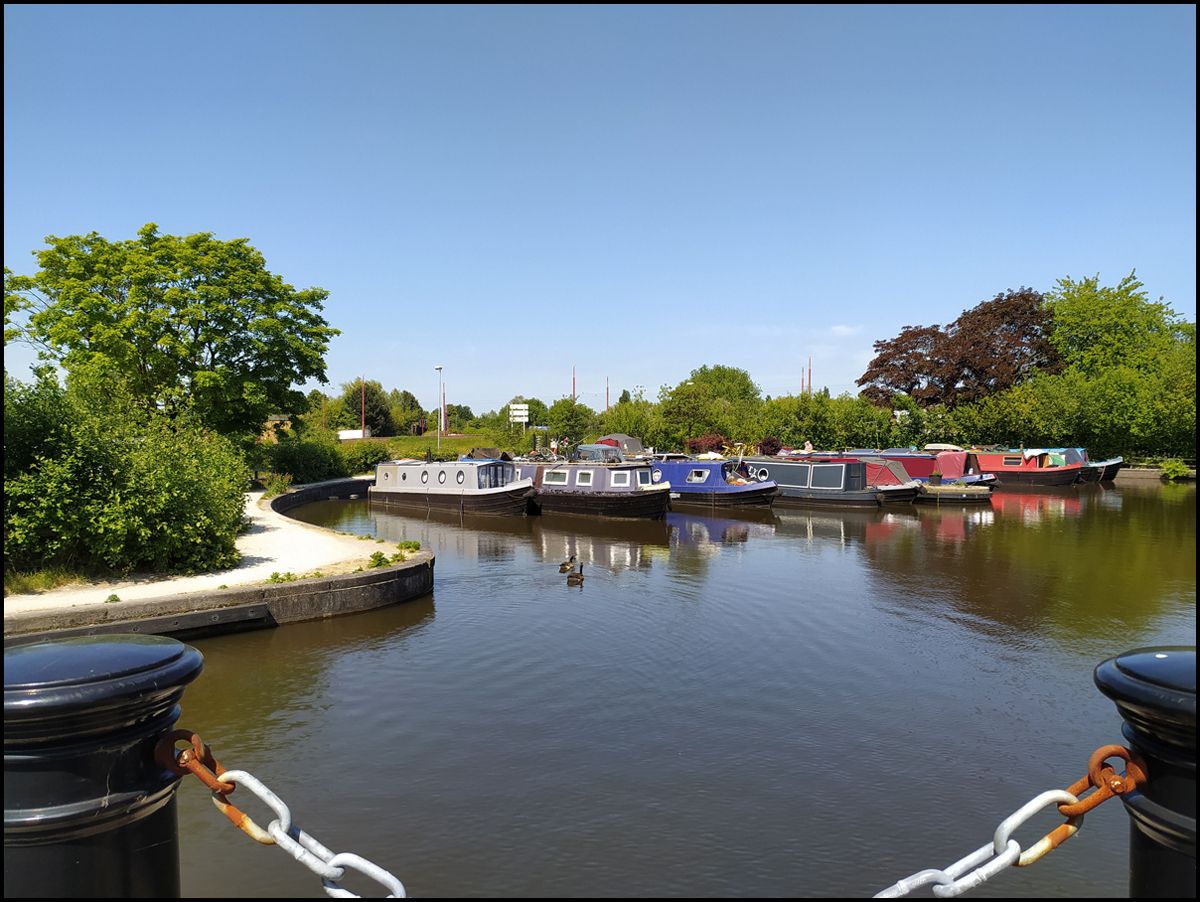
Droylsden Marina looking towards Manchester Road where the library used to be
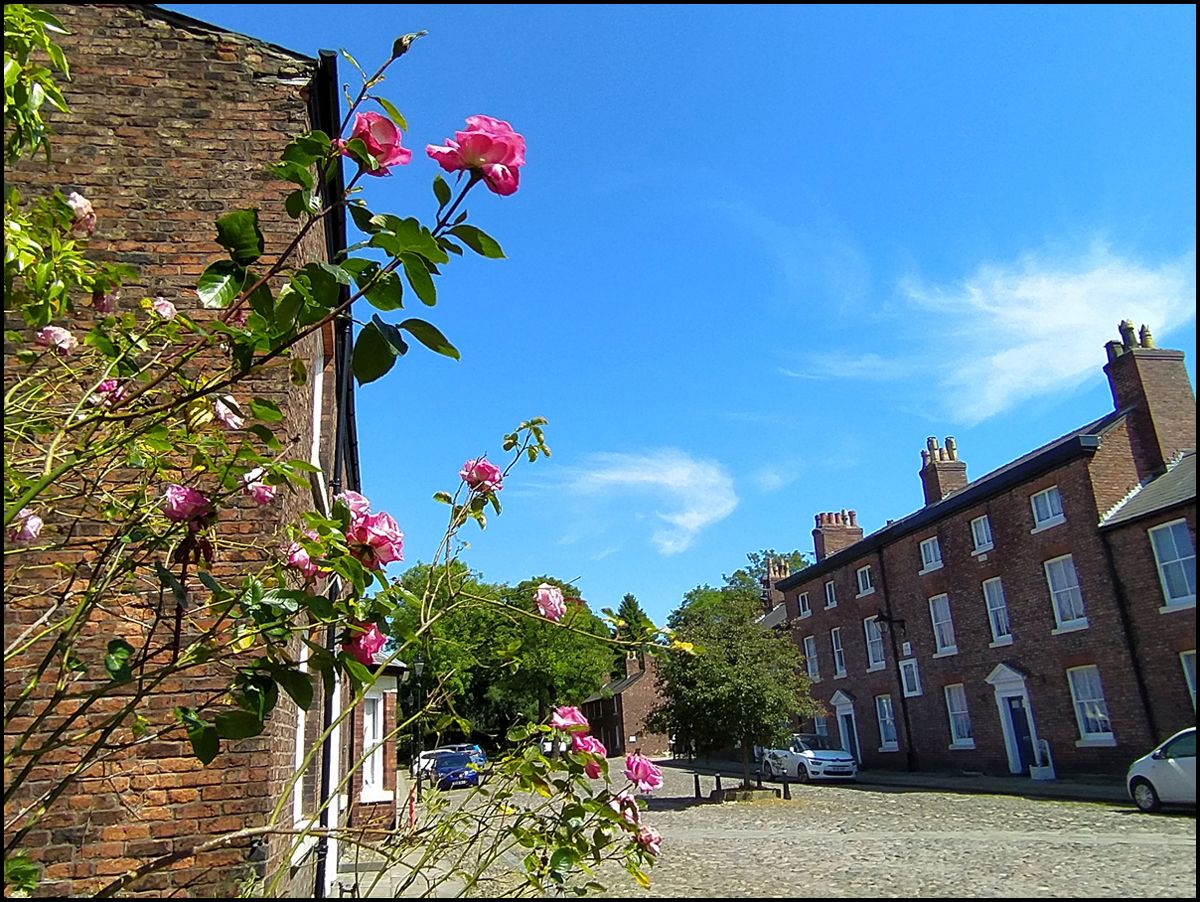
Fairfield Square looking towards the entrance on the left
No trip to Droylsden is complete without the obligatory pilgrimage to Fairfield Square, my old haunt of seven years as a pupil at Fairfield High School for Girls. I love the place, it’s like a time warp. I have many happy memories of my Fairfield schooldays. It was a lovely sunny day with a deep blue sky, ideal for taking even more photographs of the Square, as if I didn’t already have enough. But then you can’t have too much of a good thing. My gran used to sing in the choir and was married at Fairfield Moravian Church, and my mother baptized there. I decided to have a look around the Moravian Museum, yes I’ve been before, but still. When I was charged the senior citizen rate without being asked, I wasn’t sure whether to feel chuffed at saving fifty pence or slightly offended!

Sisters Street and clock tower, Fairfield Square, Droylsden
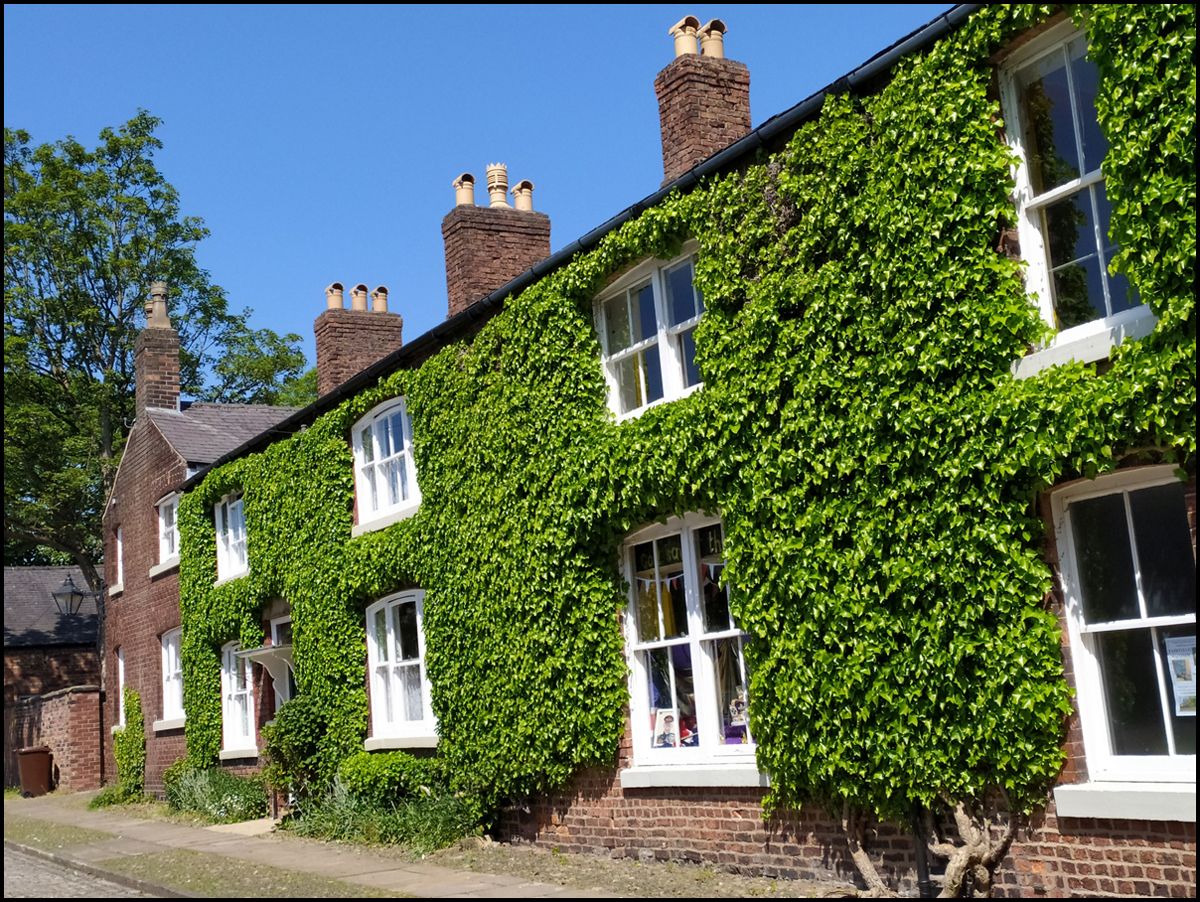
Sisters Street, Fairfield Square
On Monday morning in glorious sunshine we went on a tour of the Castlefield Viaduct. This 330 metre long Grade II-listed structure was built in 1892 by Heenan and Froude, the engineers who worked on Blackpool Tower. The viaduct was used to carry heavy rail traffic in and out of the Great Northern Warehouse until 1969.
The National Trust has transformed the viaduct into an elevated park with trees, plants and flowers. It was almost surreal standing on this magnificent structure full of plants, peering through the iron girders at the contrasting buildings. It was interesting to learn about the planting of Manchester poplars during the Great Depression. Since many trees in the city had died as a result of the heavy pollution, the Government and Manchester Parks and Cemeteries Committee introduced a project called “Unemployment Relief Works”. A panel tells us that “Men would head out on their bikes every day to plant poplar saplings and swathes of Manchester Poplars started to pop up in parks, towpaths and fields across the borough”. We also learnt that comfrey leaves were bought by cotton mill workers to line their clogs, there were gooseberry growing competitions, beech was used for everyday clogs, but ash for dancing clogs, silver birch was used for spools, bobbins and reels, sycamore for textile rollers due to its ability not to stain cloth. Overall this was an extremely informative visit and I’d definitely recommend it.
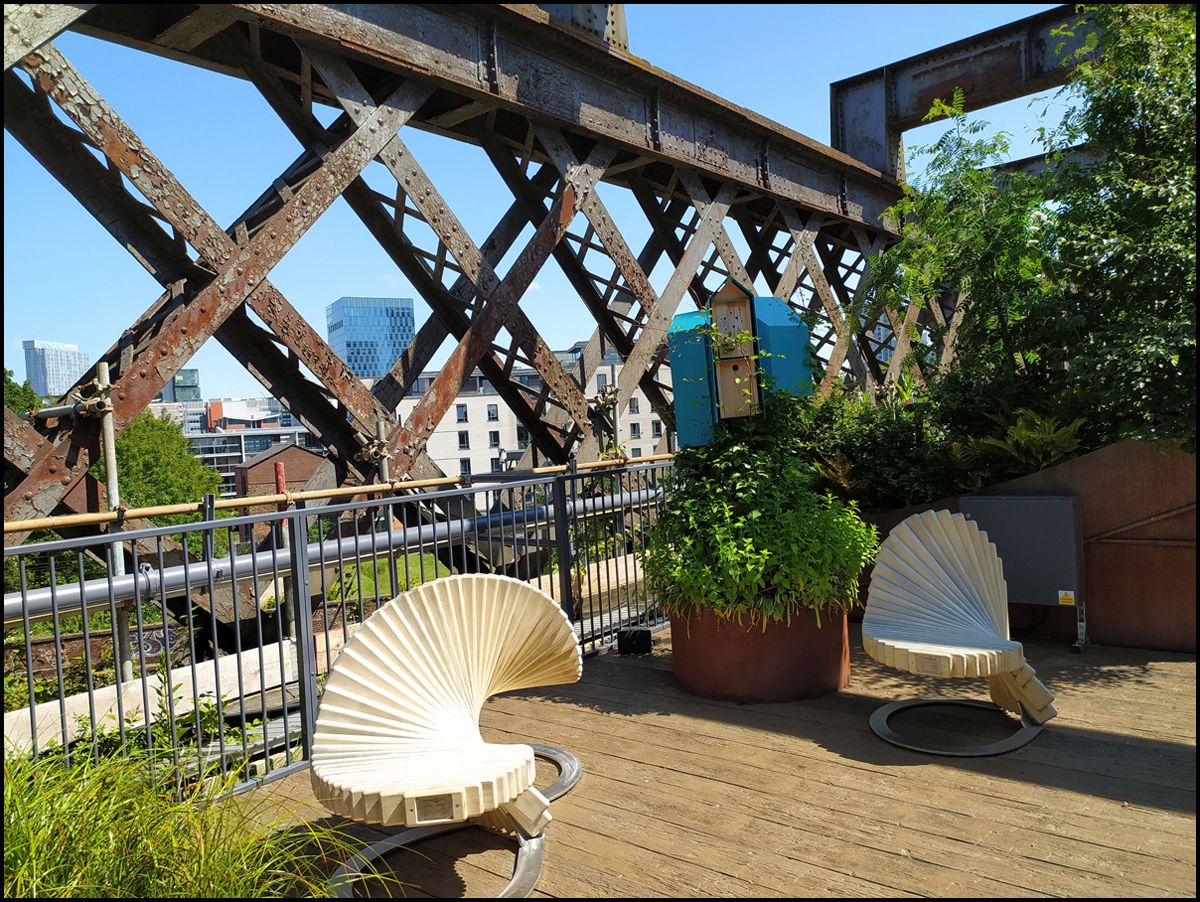
Castlefield Viaduct
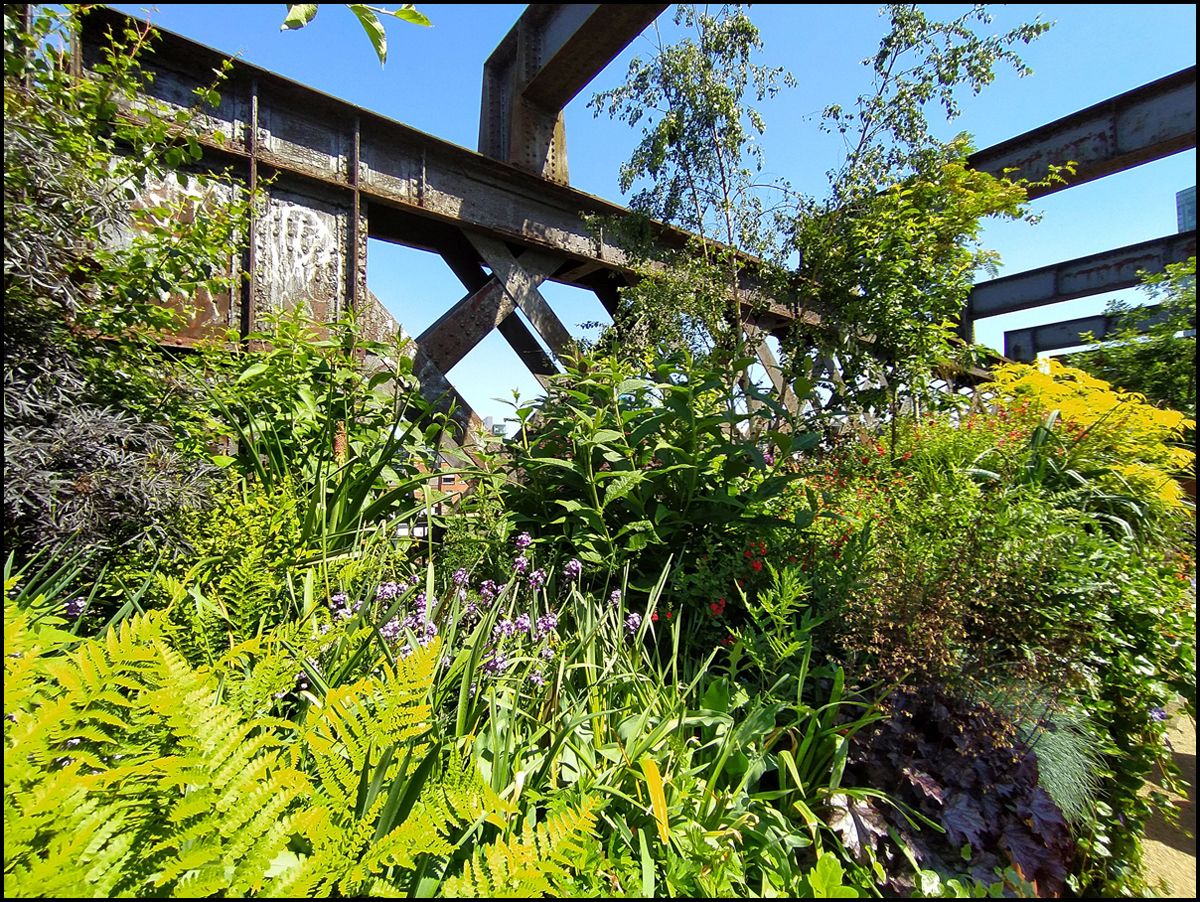
Castlefield Viaduct
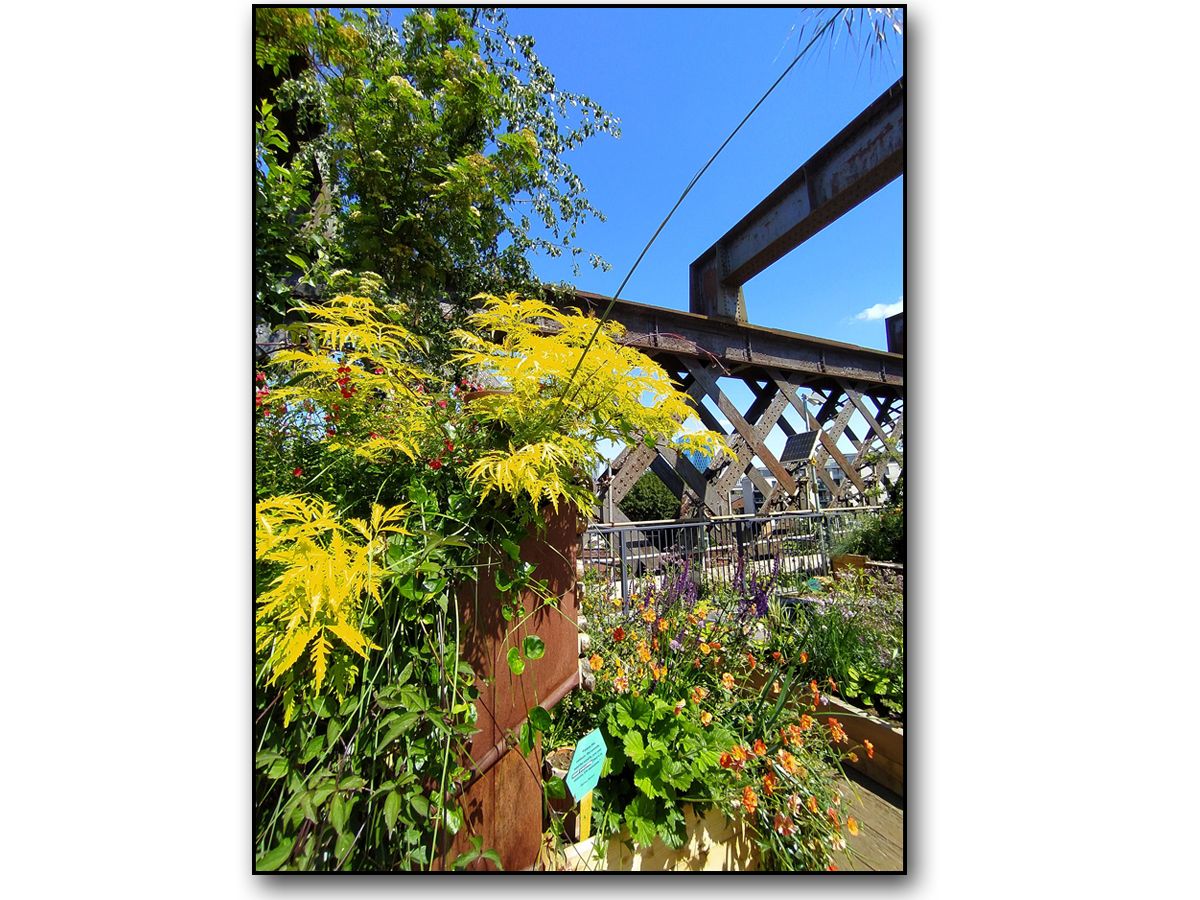
Castlefield Viaduct
Back into the centre. The Northern Quarter. Hmm. In my youth (recently...) street cafés were definitely not a thing. We used to blame it on the weather of course. But it was definitely something that people only did “on the continent”. Who would have dreamt of sitting outside with a pot of tea unless you were in your own back garden? But it did indeed start to happen, and the choice of café was no longer restricted to those with sticky Formica tabletops where the only decorative item was an even stickier tomato ketchup bottle. Attractive street cafés and restaurants were now firmly established as a part of the British culinary scene.
But surely not in Thomas Street? Stevenson Square?? The dirty back streets of Manchester. We used to wait for our bus in Stevenson Square, it was a dreary place, it always seemed to be raining. The one highlight was Fred Aldous, the craft shop. I could hardly believe it’s still there. But what surprised me most was seeing people sitting in Stevenson Square eating and drinking. Most likely a hot beverage with oat milk accompanied by something containing quinoa.
The Northern Quarter possesses a kind of morbid charm. The cracked flags and metal rimmed curbstones still recall the time when Tib Street was famous for its pet shops, and Thomas Street for its jewellers. Sleazy little streets you would scuttle through hastily, litter everywhere, smells you couldn’t or didn’t want to identify. I’m still working on getting my head around this new image
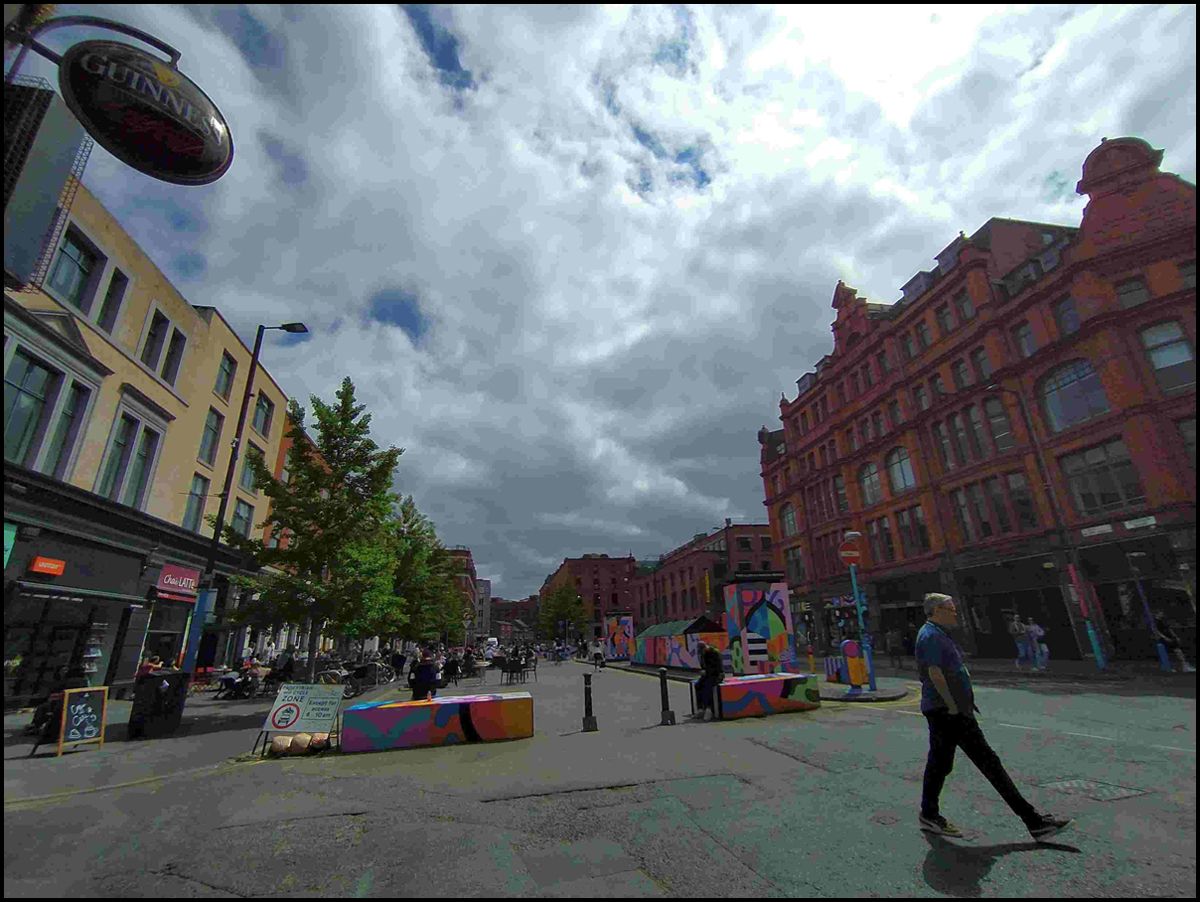
Stevenson Square
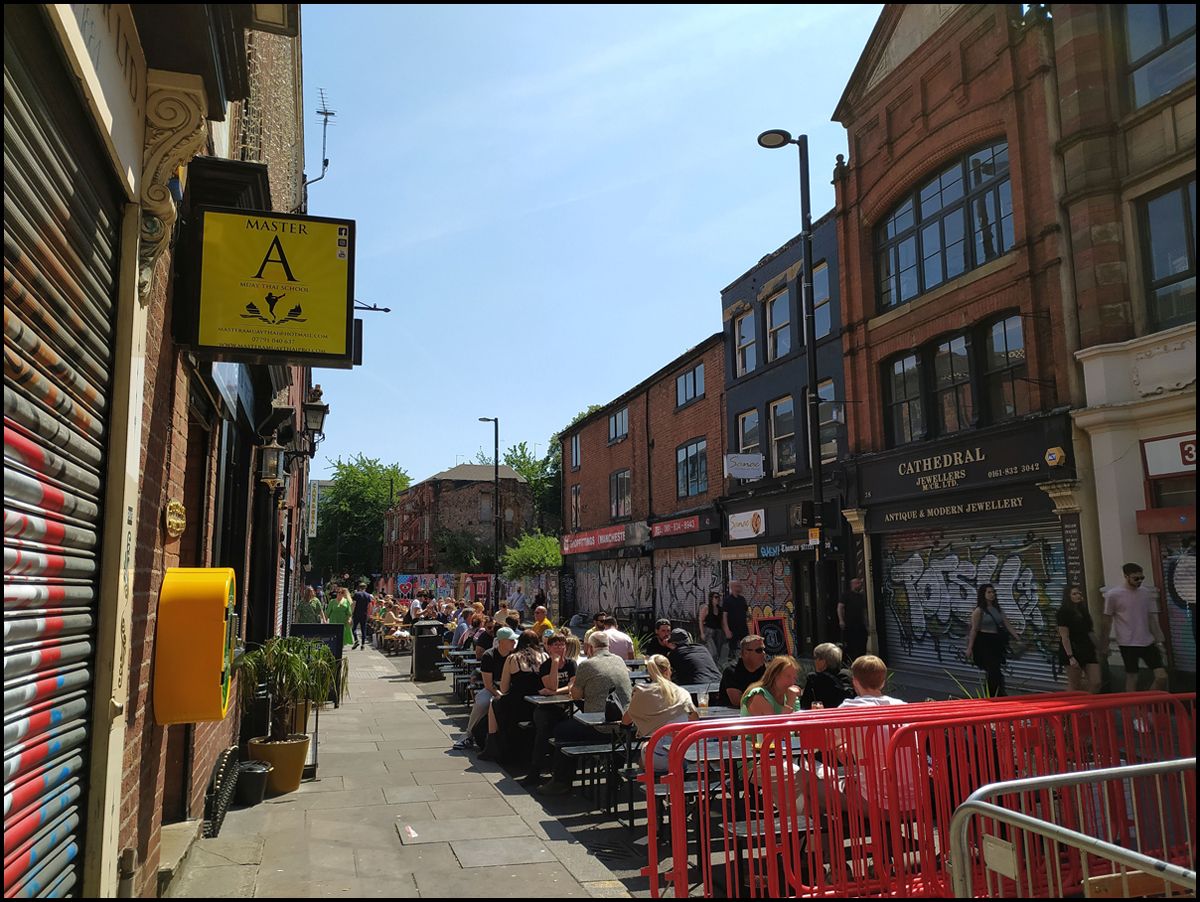
Thomas Street, Northern Quarter
Perhaps it’s because people are sitting outside that you actually take the trouble to look twice at the setting. I rediscovered the remains of Smithfield Market in High Street, it’s always been there but I had never really paid any attention to it. The same goes for many other buildings. When you walk around Manchester and consciously look at the lovely old buildings you realize just how beautiful some of them are. And nowadays they’re nice and clean, not covered in soot and dirt. I used to think that Manchester Cathedral had been built of black stone until the council began cleaning up the city. And not everything that is no longer there was worth saving anyway. The underground market for example. That was not exactly an architectural jewel. I used to shuffle around there in my lunch hour, occasionally buying cheap clothes, when I was working as a Saturday girl at True-Form on Market Street.
It’s comforting to be able to go inside Manchester Art Gallery with my favourite Pre Raphs, or John Rylands Library, or the Portico Library, whose first Secretary Peter Mark Roget wrote the first English thesaurus, or Manchester Central Library. They are all still there, with friendly staff welcoming the visitors. In fact I spent a good hour in the Central Library, having located the MLFHS helpdesk. I was able to search the 1921 Census and successfully found the families of my Gran’s four brothers. I find it quite fascinating that one James Walker from Wigtownshire is ultimately responsible for what seems like half the population of Liverpool, and a large portion of Manchester’s. There are simply too many Walkers. So I was quite thrilled to have found them.
A walk down Deansgate revealed the new complex at what is now Deansgate Square. Those four towers. They started to appear in the distance as if they were sprouting out of one of the old railway bridges near Castlefield. It was strange watching them grow in height as the former Knott Mill, now Deansgate, station got nearer. And there’s another one being built – Three60, Manchester’s first cylindrical skyscraper. I felt very uncomfortable standing at the foot of these towers and managed to lose my bearings completely. For a split second I thought I would never be able to escape from the looming monstrosities. On the way back a short stop at Quay Street. Sunlight House. My father used to work there when he was with British Rail, I remember going with my mother to the scary swimming pool in the basement during my father’s lunch hour. It had big pillars in the pool that you had to circumnavigate, and that scared me to death. I was glad we didn’t go again. Sunlight House and Kendals, Victoria Station, the Royal Exchange, and the bollards and litter bins with the familiar Manchester bees, lulled me back into my comfort zone. My Manchester.
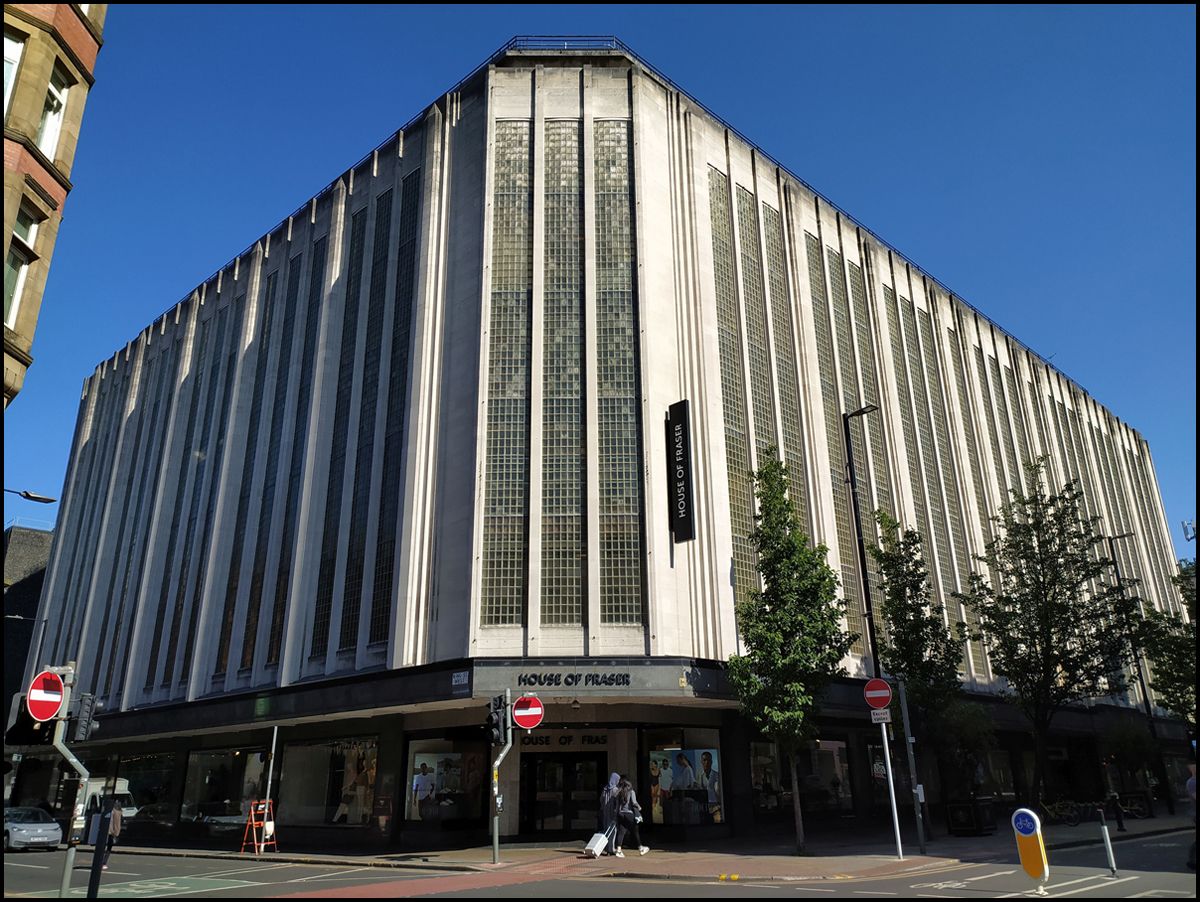
Kendals, Deansgate
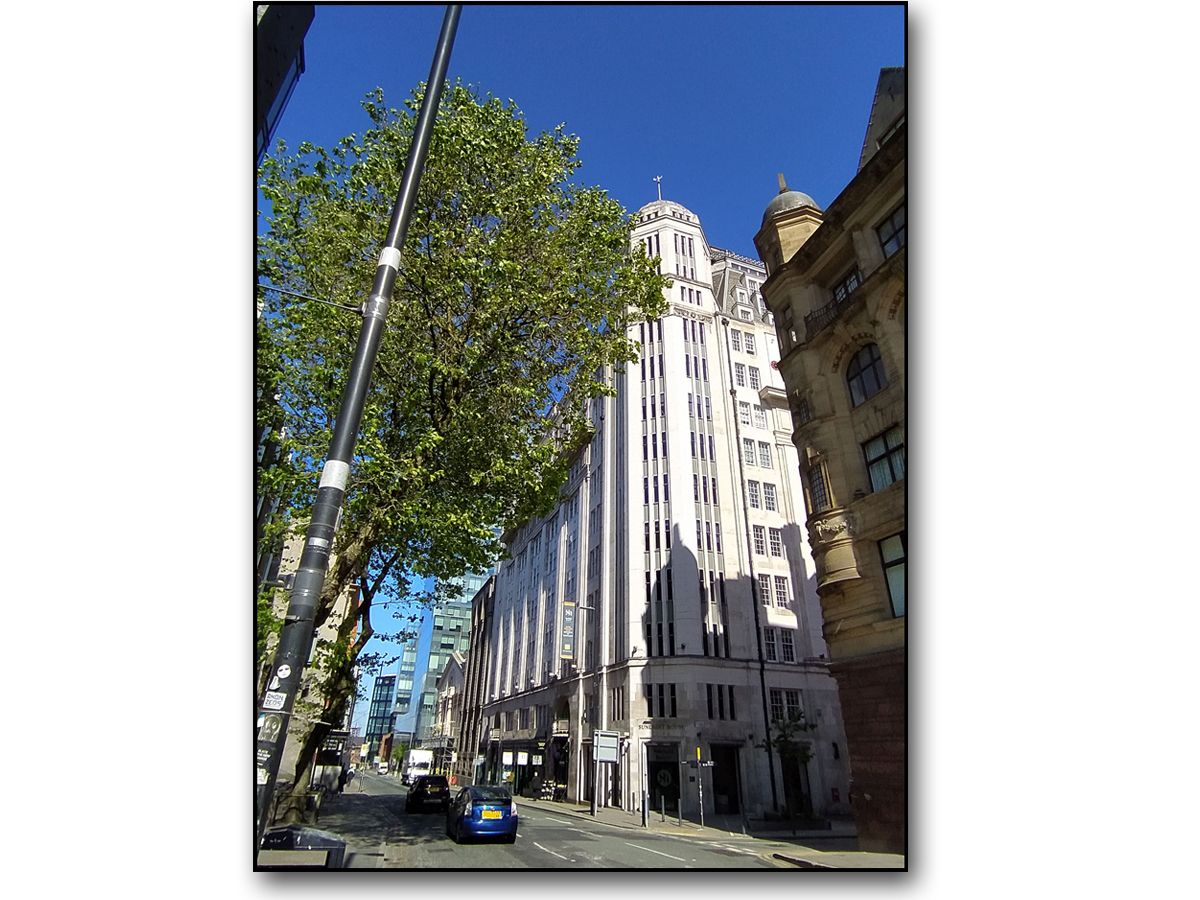
Sunlight House, Quay-Street
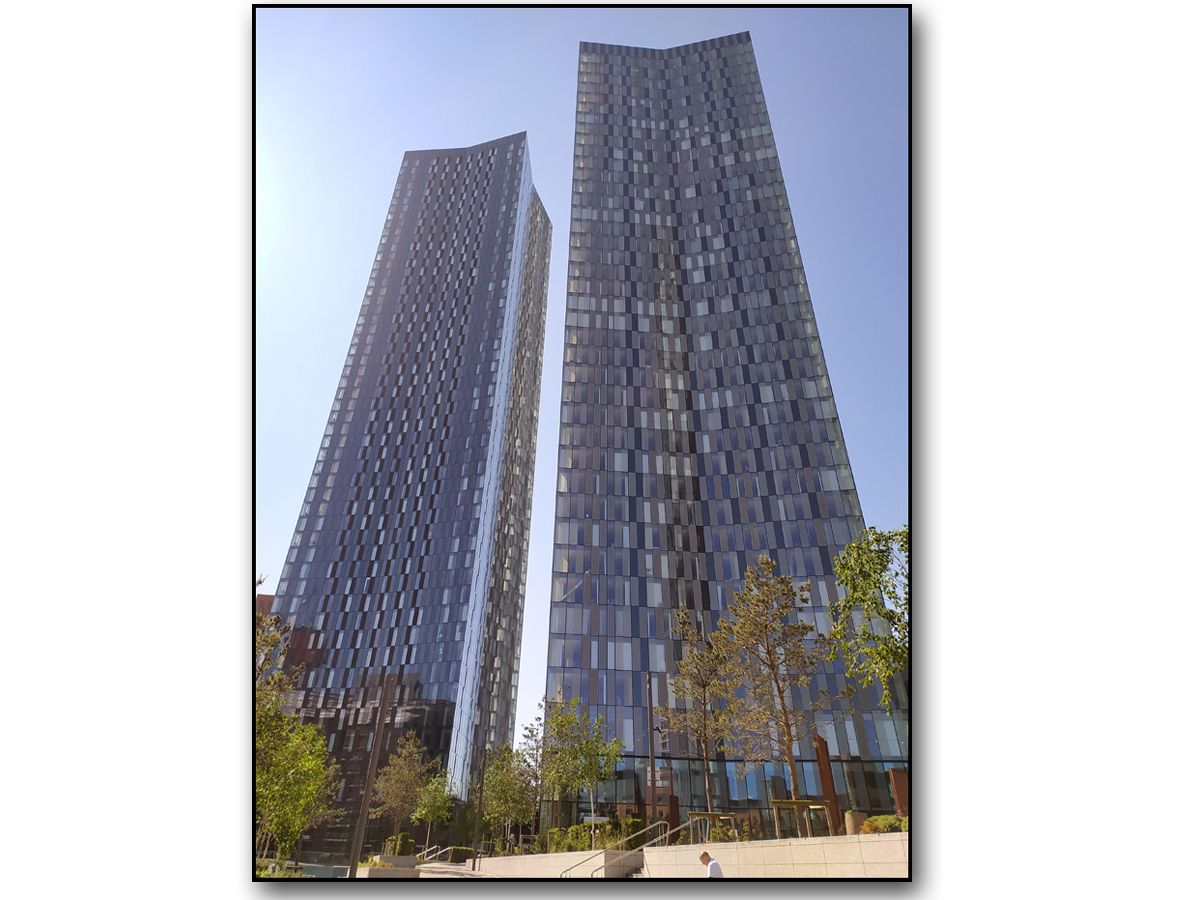
The Towers, Deansgate Square
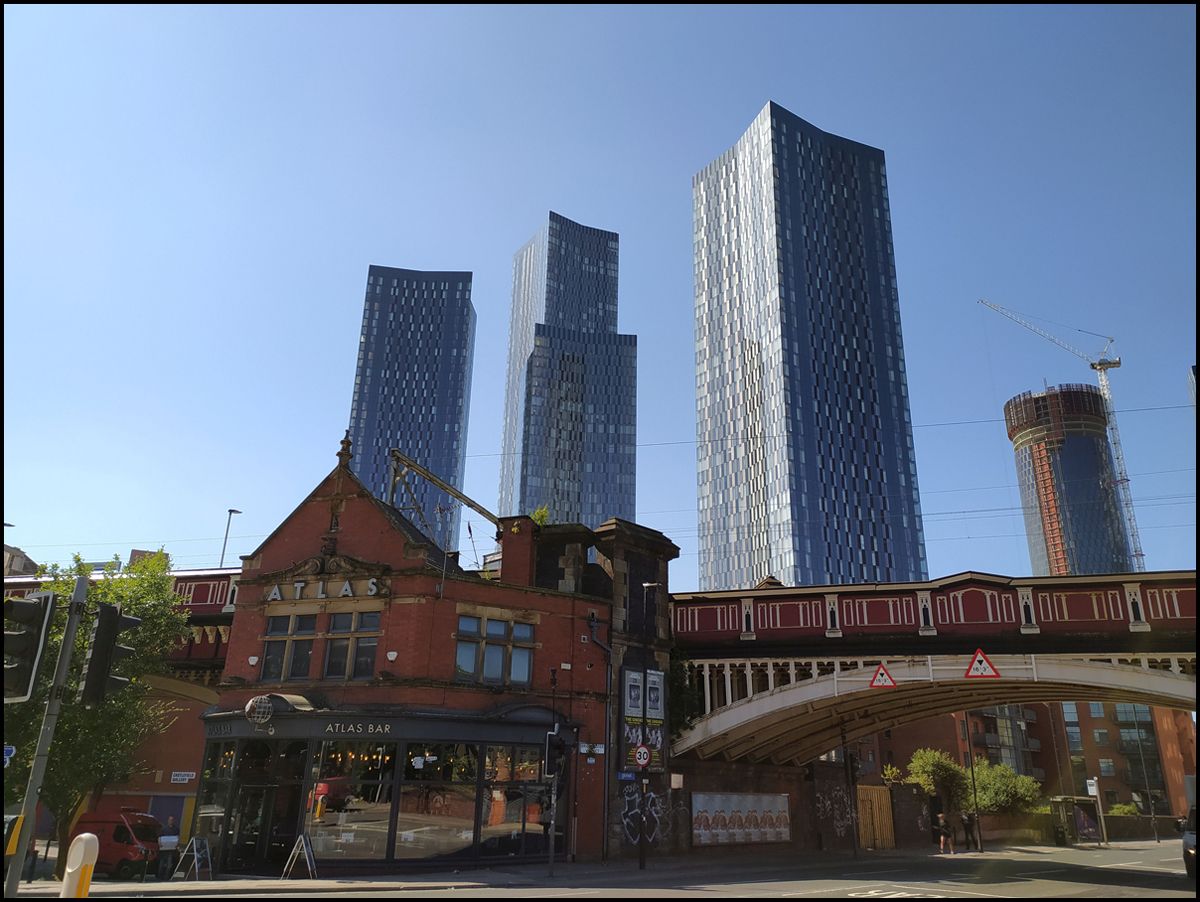
Deansgate Station, formerly Knott Mill
At the beginning of our visit I felt as if Manchester was a very different city, unfamiliar and full of new buildings I didn’t particularly appreciate. It took about a week to reclaim and rediscover my Manchester, and even to discover things that had always been there but that I simply hadn’t noticed before.
© Julie Schwethelm, 2023